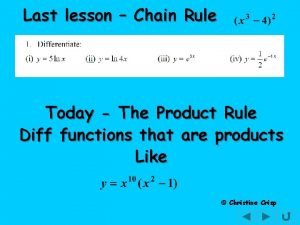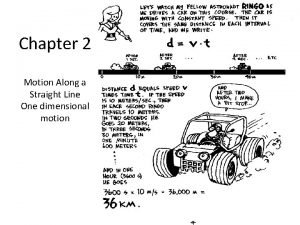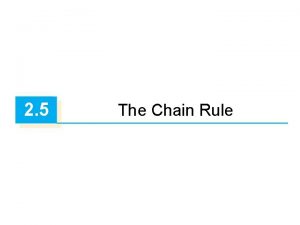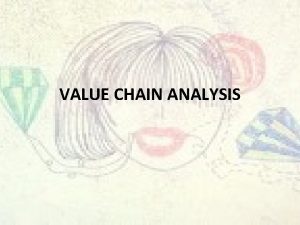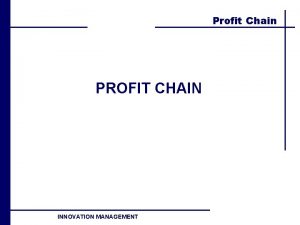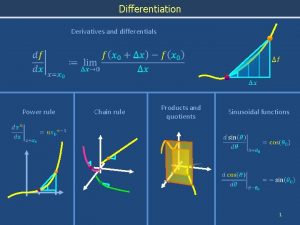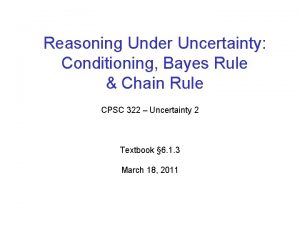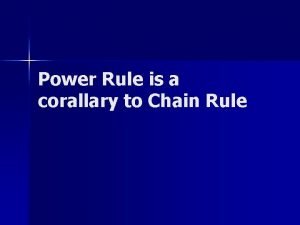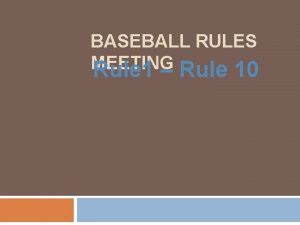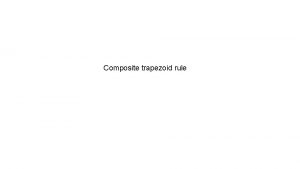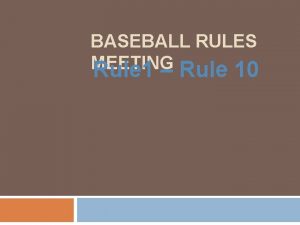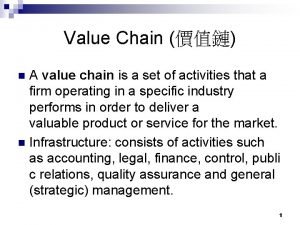14 5 The Chain Rule The Chain Rule



























- Slides: 27

14. 5 The Chain Rule

The Chain Rule Recall the Chain Rule for functions of a single variable: If y = f (x) and x = g(t), where f and g are differentiable functions, then For functions of more than one variable, the Chain Rule has several versions: • variables x, y, … depend only on one variable t or • variables x, y, … depend on more than one variable 2

The Chain Rule – Case 1: z = f (x, y) and each of the variables x and y is a function of a variable t. 3

Example: If z = x 2 y + 3 xy 4, where x = sin 2 t and y = cos t, find dz/dt when t = 0. Solution: By Chain Rule: = (2 xy + 3 y 4)(2 cos 2 t) + (x 2 + 12 xy 3)(–sin t) It’s not necessary to substitute the expressions for x and y in terms of t. when t = 0: we have x = sin 0 = 0 and y = cos 0 = 1 = (0 + 3)(2 cos 0) + (0 + 0)(–sin 0) = 6 4

The Chain Rule: Case 2: z = f (x, y) but each of x and y is a function of two variables s and t : x = g(s, t), y = h(s, t). Then z is indirectly a function of s and t and we want to find ∂z/∂s and ∂z/∂t. Recall that in computing ∂z/∂t we hold s fixed and compute the ordinary derivative of z with respect to t. Therefore we can apply Case 1 rule to obtain: and similarly ∂z/∂s 5

The Chain Rule: Case 2 Finally: Case 2 of the Chain Rule contains three types of variables: s and t are independent variables, x and y are called intermediate variables, and z is the dependent variable. 6

Tree diagram of the variables: To remember the Chain Rule, it’s helpful to draw this tree diagram: We draw branches from the dependent variable z to the intermediate variables x and y to indicate that z is a function of x and y. Then we draw branches from x and y to the independent variables s and t. On each branch we write the corresponding partial derivative. To find ∂z/∂s, we find the product of the partial derivatives along each path from z to s and then add these products: Similarly, we find ∂z/∂t by using the paths from z to t. 7

The Chain Rule - most general case: For n intermediate variables and m independent variables Now we consider the general situation in which a dependent variable u is a function of n intermediate variables x 1, …, xn, each of which is, in turn, a function of m independent variables t 1, …, tm. Notice that there are n terms, one for each intermediate variable. 8

Example 1: 9

Example 1 - Answers a) With 10

Example 1 - Answers b) 11

Example 2: SOLUTION: 12

SOLUTION (continued) 13

Example 3: 14

Example 3 - solution (a) Tree diagram: 15

Example 3 - solution (b) Tree diagram: 16

Higher Order Derivatives: Same rules apply! Example: Find: Answer: Long and messy 17

Solution: First derivative: Second derivative: We must use the product rule on the right hand side! Now, we need to find: 18

Solution (continued) Starting from the first derivative: and 19

Solution (continued) Use these back in the second derivative and simplify: 20

Implicit Differentiation 21

Implicit Differentiation Suppose that an equation of the form F (x, y) = 0 defines y implicitly as a differentiable function of x: y = f (x), and F (x, f (x)) = 0 for all x in the domain of f. If F is differentiable, we can apply Case 1 of the Chain Rule to differentiate both sides of the equation F (x, y) = 0 with respect to x. But dx/dx = 1, so if ∂F/∂x ≠ 0 we solve for dy/dx and obtain 22

Example: Find y if x 3 + y 3 = 6 xy. Solution: The given equation can be written as F (x, y) = x 3 + y 3 – 6 xy = 0 so 23

Implicit Differentiation: with 2 independent variables Now we suppose that z is given implicitly as a function z = f (x, y) by an equation of the form F (x, y, z) = 0. Use the Chain Rule to differentiate the equation F (x, y, z) = 0 : But Solve for ∂z/∂x. and so the equation becomes: The formula for ∂z/∂y is obtained in a similar manner. 24

Implicit Differentiation: with 2 independent variables or: 25

Example: SOLUTION: 26

Solution (continued) So: 27
 Food chain food chain food chain
Food chain food chain food chain What is the cold chain rule
What is the cold chain rule Chain rule power rule
Chain rule power rule Hình ảnh bộ gõ cơ thể búng tay
Hình ảnh bộ gõ cơ thể búng tay Lp html
Lp html Bổ thể
Bổ thể Tỉ lệ cơ thể trẻ em
Tỉ lệ cơ thể trẻ em Gấu đi như thế nào
Gấu đi như thế nào Tư thế worms-breton
Tư thế worms-breton Bài hát chúa yêu trần thế alleluia
Bài hát chúa yêu trần thế alleluia Môn thể thao bắt đầu bằng từ đua
Môn thể thao bắt đầu bằng từ đua Thế nào là hệ số cao nhất
Thế nào là hệ số cao nhất Các châu lục và đại dương trên thế giới
Các châu lục và đại dương trên thế giới Công thức tiính động năng
Công thức tiính động năng Trời xanh đây là của chúng ta thể thơ
Trời xanh đây là của chúng ta thể thơ Mật thư tọa độ 5x5
Mật thư tọa độ 5x5 101012 bằng
101012 bằng Phản ứng thế ankan
Phản ứng thế ankan Các châu lục và đại dương trên thế giới
Các châu lục và đại dương trên thế giới Thể thơ truyền thống
Thể thơ truyền thống Quá trình desamine hóa có thể tạo ra
Quá trình desamine hóa có thể tạo ra Một số thể thơ truyền thống
Một số thể thơ truyền thống Bàn tay mà dây bẩn
Bàn tay mà dây bẩn Vẽ hình chiếu vuông góc của vật thể sau
Vẽ hình chiếu vuông góc của vật thể sau Biện pháp chống mỏi cơ
Biện pháp chống mỏi cơ đặc điểm cơ thể của người tối cổ
đặc điểm cơ thể của người tối cổ Thế nào là giọng cùng tên? *
Thế nào là giọng cùng tên? * Vẽ hình chiếu đứng bằng cạnh của vật thể
Vẽ hình chiếu đứng bằng cạnh của vật thể

